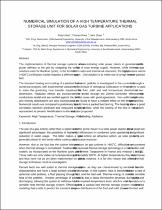 ResearchSpace
ResearchSpace
Numerical simulation of a high temperature thermal storage unit for solar gas turbine applications
JavaScript is disabled for your browser. Some features of this site may not work without it.
- ResearchSpace
- →
- Research Publications/Outputs
- →
- Conference Publications
- →
- View Item
| dc.contributor.author |
Klein, Peter

|
|
| dc.contributor.author |
Roos, T

|
|
| dc.contributor.author |
Sheer, J

|
|
| dc.date.accessioned | 2011-08-11T13:22:31Z | |
| dc.date.available | 2011-08-11T13:22:31Z | |
| dc.date.issued | 2010-09 | |
| dc.identifier.citation | Klein, P, Roos, T, and Sheer, J. 2010. Numerical simulation of a high temperature thermal storage unit for solar gas turbine applications. 16th SolarPACES2010 Conference, Perpignan, France, 21-24 September 2010, pp. 8 | en_US |
| dc.identifier.uri | http://hdl.handle.net/10204/5128 | |
| dc.description | 16th SolarPACES2010 Conference, Perpignan, France, 21-24 September 2010 | en_US |
| dc.description.abstract | The implementation of thermal storage systems allows concentrating solar power plants to generate predictable power delivery to the grid by mitigating the variability of solar energy supply. However, while thermal storage solutions exist for Rankine cycles, in the form of molten salts and thermal oil reservoirs, the high temperature nature (>800°C) of Brayton cycles requires a different approach. One solution is to make use of a high temperature packed bed. The transient heating and cooling of a packed bed of ceramic pebbles is investigated in the current work through a numerical analysis, with experimental validation. The technique of orthogonal collocation on finite elements is used to solve the governing heat transfer equations for the fluid, solid and wall temperature distributions in two dimensions. Radiation effects are incorporated in the model through the Zehner-Schlünder effective thermal conductivity model and are verified against the SANA test cases with good agreement. Non-uniform radial porosity and velocity distributions are also incorporated and are found to have a notable effect on the temperature profiles. Numerical results are compared to preliminary test results from a packed bed test rig. The heating tests show a good correlation between predicted and measured temperature profiles, while the cooling of the bed is not accurately represented at present. Modifications to the test setup are proposed. | en_US |
| dc.language.iso | en | en_US |
| dc.relation.ispartofseries | Workflow;5969 | |
| dc.subject | High temperature | en_US |
| dc.subject | Thermal storage | en_US |
| dc.subject | Wall channeling | en_US |
| dc.subject | Radiation | en_US |
| dc.title | Numerical simulation of a high temperature thermal storage unit for solar gas turbine applications | en_US |
| dc.type | Conference Presentation | en_US |
| dc.identifier.apacitation | Klein, P., Roos, T., & Sheer, J. (2010). Numerical simulation of a high temperature thermal storage unit for solar gas turbine applications. http://hdl.handle.net/10204/5128 | en_ZA |
| dc.identifier.chicagocitation | Klein, Peter, T Roos, and J Sheer. "Numerical simulation of a high temperature thermal storage unit for solar gas turbine applications." (2010): http://hdl.handle.net/10204/5128 | en_ZA |
| dc.identifier.vancouvercitation | Klein P, Roos T, Sheer J, Numerical simulation of a high temperature thermal storage unit for solar gas turbine applications; 2010. http://hdl.handle.net/10204/5128 . | en_ZA |
| dc.identifier.ris | TY - Conference Presentation AU - Klein, Peter AU - Roos, T AU - Sheer, J AB - The implementation of thermal storage systems allows concentrating solar power plants to generate predictable power delivery to the grid by mitigating the variability of solar energy supply. However, while thermal storage solutions exist for Rankine cycles, in the form of molten salts and thermal oil reservoirs, the high temperature nature (>800°C) of Brayton cycles requires a different approach. One solution is to make use of a high temperature packed bed. The transient heating and cooling of a packed bed of ceramic pebbles is investigated in the current work through a numerical analysis, with experimental validation. The technique of orthogonal collocation on finite elements is used to solve the governing heat transfer equations for the fluid, solid and wall temperature distributions in two dimensions. Radiation effects are incorporated in the model through the Zehner-Schlünder effective thermal conductivity model and are verified against the SANA test cases with good agreement. Non-uniform radial porosity and velocity distributions are also incorporated and are found to have a notable effect on the temperature profiles. Numerical results are compared to preliminary test results from a packed bed test rig. The heating tests show a good correlation between predicted and measured temperature profiles, while the cooling of the bed is not accurately represented at present. Modifications to the test setup are proposed. DA - 2010-09 DB - ResearchSpace DP - CSIR KW - High temperature KW - Thermal storage KW - Wall channeling KW - Radiation LK - https://researchspace.csir.co.za PY - 2010 T1 - Numerical simulation of a high temperature thermal storage unit for solar gas turbine applications TI - Numerical simulation of a high temperature thermal storage unit for solar gas turbine applications UR - http://hdl.handle.net/10204/5128 ER - | en_ZA |





